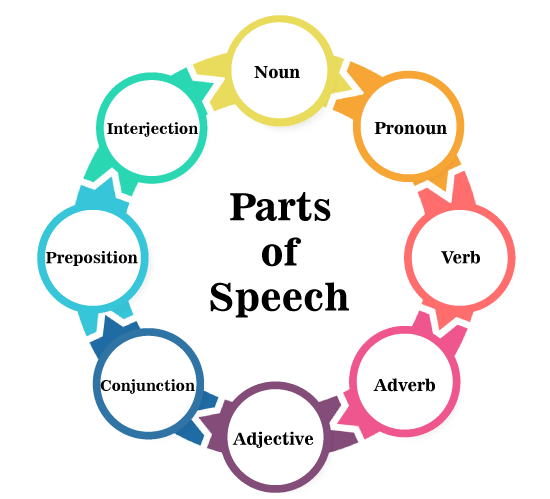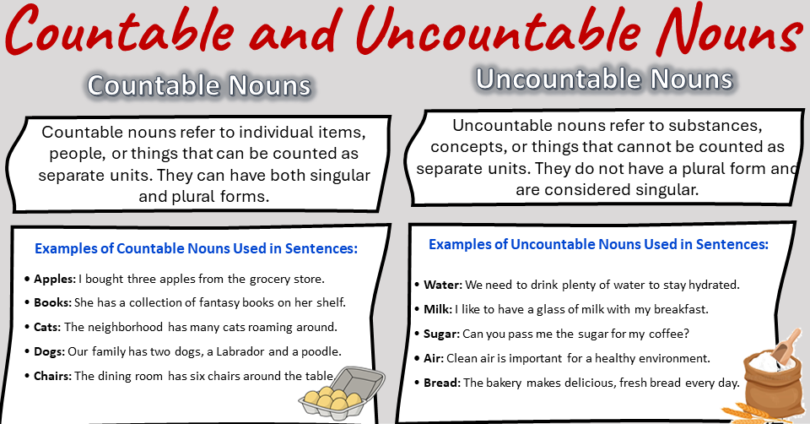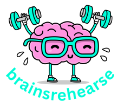PARTS OF SPEECH
Learn English Grammar from basics with the 8 parts of speech with simple definition and examples.
The parts of speech chart is like a helpful tool that sorts words in English sentences based on what they do. It’s like a map that shows you the different jobs words can have in sentences, such as naming things (nouns), doing actions (verbs), describing things (adjectives), describing actions (adverbs), taking the place of nouns (pronouns), showing relationships (prepositions), connecting ideas (conjunctions), and expressing strong feelings (interjections).8 parts of speech with simple definition and examples.
When you use this chart, you can quickly figure out what a word is doing in a sentence and how it fits with other words.8 parts of speech with simple definition and examples..

Understanding the parts of speech is like unlocking the secret code of language. Whether you’re learning a new language or striving to improve your writing and communication skills in your native tongue, a solid grasp of parts of speech is fundamental.
In this post we’ll break down the various parts of speech in a straightforward and accessible way, making it easier than ever to navigate the intricacies of language. let’s make English Grammar interesting with the help of parts of speech. 8 parts of speech with definition and examples
Read also…http://Direct and Indirect Speech
What Are Parts of Speech?
Parts of Speech(8 parts of speech with simple definition and examples. )
Parts of speech are the building blocks of language. They categorize words into distinct groups based on their functions and relationships within sentences. There are eight primary parts of speech to explore learn English Grammar from basics with the 8 parts of speech.8 parts of speech with definition and examples.
8 parts of speech with simple definition and examples.
(1) Noun (2) Pronoun (3) Adjective (4) Verb (5) Adverb (6) Preposition (7) Conjunction (8) Interjection
https://youtu.be/0l69KEx7GQo?si=RjT1O8lEds6R6UOI
8 parts of speech with simple definition and examples.
Noun: Nouns are words that represent people, places, things, or ideas. Examples include “dog,” “book,” “friendship,” and “New York.”

Pronoun: Pronouns replace nouns to avoid repetition. Common pronouns include “he,” “she,” “it,” “they,” and “myself.”
Verb: Verbs are action words that describe what someone or something is doing. “Run,” “write,” “sing,” and “eat” are all verbs.

Adjective: Adjectives modify nouns to provide more information about them. For instance, “red” in “red apple” or “happy” in “happy child.”
Certainly, here are the types of adjectives in a simpler manner:
-
Descriptive adjective (Adjective of quality)
-
Quantity adjective (Adjective of quantity)
-
Number adjective (Adjective of number)
-
Demonstrative adjective
-
Distributive adjective
-
Questioning adjective (Interrogative adjective)

Adverb: A word which is used to give additional meaning to a verb or an adjective is called as Adverb.

There are following kinds of Adverb.
-
Time of adverb
-
Frequency of adverb
-
Place of adverb
-
Manner of adverb
-
Quantity of adverb
Preposition: Prepositions show the relationship between nouns or pronouns and other words in a sentence. Common prepositions include “in,” “on,” “under,” “over,” and “between.”
Conjunction: Conjunctions connect words, phrases, or clauses within a sentence. Words like “and,” “but,” “or,” and “because” are conjunctions.
Interjection: Interjections express strong emotions and are often followed by an exclamation mark. Examples include “Wow!,” “Ouch!,” and “Oh!”

Countable and Uncountable Nouns: Rules and Examples(8 parts of speech with simple definition and examples)
In English grammar, nouns are categorized into two main groups: countable nouns and uncountable nouns (also known as count nouns and non-count nouns). These categories have specific grammatical rules and usage patterns. Here’s an overview of countable and uncountable nouns:

Countable Nouns:
Definition: Countable nouns refer to individual items, people, or things that can be counted as separate units. They can have both singular and plural forms. 8 parts of speech with definition and examples
Examples: apple, book, car, dog, chair, student, house, pencil, computer, cup, etc.
Grammatical Characteristics:
• Can be used with both singular and plural articles (a, an, the, these, those, etc.).
• Can be preceded by numbers (one book, two cars) and quantifiers (some, many, few, several, etc.).
• Take plural forms when referring to more than one item (apples, books, cars, etc.).
• Require plural verbs when used in sentences (The books are on the shelf).
Examples of Countable Nouns Used in Sentences:
• Apples: I bought three apples from the grocery store.
• Books: She has a collection of fantasy books on her shelf.
• Cats: The neighborhood has many cats roaming around.
• Dogs: Our family has two dogs, a Labrador and a poodle.
• Chairs: The dining room has six chairs around the table.
• Students: The school organized a field trip for the students.
• Hats: He tried on several hats before choosing one for the party.
• Balls: The kids were playing with colorful balls in the park.
• Cars: My neighbor has a garage full of vintage cars.
• Pencils: Can I borrow one of your pencils for the exam?
Read also-https://brainsrehearse.com/index.php/2023/09/29/direct-and-indirect-with-definition-and-examples/
Uncountable Nouns:
Definition: Uncountable nouns refer to substances, concepts, or things that cannot be counted as separate units. They do not have a plural form and are considered singular.
Examples: water, milk, sugar, information, furniture, rice, money, advice, music, weather, etc.
Examples of Uncountable Nouns Used in Sentences:
• Water: We need to drink plenty of water to stay hydrated.
• Milk: I like to have a glass of milk with my breakfast.
• Sugar: Can you pass me the sugar for my coffee?
• Flour: She used whole wheat flour to bake the bread.
• Coffee: He enjoys the aroma of freshly brewed coffee in the morning.
• Tea: Would you like a cup of tea with honey?
• Juice: The kids love to have orange juice with their pancakes.
• Wine: They brought a bottle of red wine to the dinner party.
• Air: Clean air is important for a healthy environment.
• Bread: The bakery makes delicious, fresh bread every day.
• Butter: She spread butter on her toast and sprinkled cinnamon.
• Cheese: The cheese in this lasagna is rich and creamy.
• Chocolate: I have a weakness for dark chocolate.
• Honey: Honey is a natural sweetener used in many recipes.
• Jam: Would you like some toast with jam for breakfast?
• Oil: Olive oil is often used in Mediterranean cuisine.
• Rice: We had rice with curry for dinner last night.
• Soup: A bowl of hot soup is perfect on a chilly day.
• Meat: He prefers to grill meat on the weekends.
• Fish: The restaurant serves a variety of fresh fish dishes.





Pingback: Past Tenses With Best Four Structure Definition | Examples |